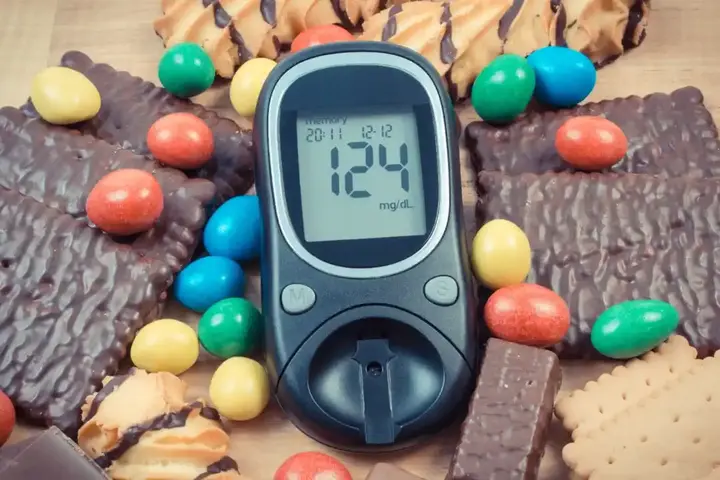Diabetic? Let's put a diet that works for you

Managing diabetes can seem stressful, especially when it comes to finding the right diet for your lifestyle. With so many conflicting tips, it's easy to get torn between do's and don'ts. But the truth is that there is no one-size-fits-all diet when it comes to diabetes. Each body has its own needs and preferences. The key is to create a personalized nutritional plan that will help you control your blood sugar level and provide you with nutrition and a feeling of satiety.
Show key points
- Managing diabetes effectively requires a personalized nutritional plan tailored to individual needs rather than relying on a universal diet.
- Including lean proteins like fish, eggs, tofu, and legumes in meals can stabilize blood sugar levels and enhance satiety.
- Whole grains such as quinoa and brown rice provide slow-digesting carbohydrates and fiber, which prevent sudden spikes in blood glucose.
- ADVERTISEMENT
- Adding healthy fats from sources like avocados, nuts, and olive oil benefits heart health and has a minimal impact on blood sugar.
- Non-starchy vegetables like broccoli and bell peppers contribute essential nutrients while being low in calories and carbohydrates.
- Breakfast options such as whey protein, eggs, and Greek yogurt are effective choices for improving insulin sensitivity and managing glucose levels.
- Balanced meals for lunch and dinner—like grilled chicken, lentil soup, quinoa salad, and steamed vegetables—support blood sugar regulation and offer vital nutrients.
In this article, we will give you practical tips to help you design a diet that suits your specific needs. Whether you're newly diagnosed or you're looking to improve your current eating habits, we'll give you guidelines to help you get started.
Recommend
The main components of a diet suitable for diabetics

• Lean proteins
Adding lean proteins in your meals can help regulate your blood sugar levels and make you feel full. Options such as skinless chicken, fish, eggs, tofu, and legumes provide essential amino acids without excess fat or calories.
• Whole grains
Whole grains, such as quinoa, brown rice, and whole grain bread, provide complex carbohydrates that digest slowly, preventing high blood sugar levels. They also contain fiber, which supports digestive health and promotes feelings of satiety.
• Healthy fats
Including healthy fats, such as avocados, nuts, seeds, and olive oil, can help improve heart health and help you feel good. These fats also have minimal impact on blood sugar levels, making them a smart choice at any meal.
• Non-starchy vegetables
Filling your plate with non-starchy vegetables like spinach, broccoli, zucchini, and bell peppers is an excellent way to add volume to your meals without too many calories or carbs. They are rich in vitamins, minerals and antioxidants that support overall health.
Breakfast diet for diabetics

Breakfast items that help fight diabetes
• Whey Protein
Whey protein powder can be added to smoothies or drinks at breakfast. Many doctors recommend that diabetics increase their protein intake to 30% to 35% of their total daily calories, as whey protein has been shown to be effective in managing blood sugar levels. Whey protein can slow glucose absorption, reduce blood sugar spikes after meals, and improve insulin sensitivity.
•Eggs
Eggs are actually a sugar-fighting nutritional force, providing 9 essential amino acids, being low in calories and rich in omega-3 fats that are good for heart health. Eggs can improve the regulation of blood sugar levels.
• Greek yogurt
Greek yogurt is an amazing food to fight diabetes at breakfast. It is rich in protein, an essential nutrient for blood sugar balance, and has little effect on blood sugar levels after meals.
Some examples of a healthy and diabetic breakfast

1. Avocado with fried eggs
This dish is a great option for balancing and stabilizing blood sugar levels. Avocados contain healthy fats and omega-3s, while fried eggs add lean protein, making it a nutrient-rich and filling meal.
2. Egg omelette with grilled vegetables
This omelette contains fiber from grilled vegetables, which helps slow digestion and contributes to stabilizing blood sugar levels. It is a delicious meal full of vitamins and essential nutrients.
3. Sweet potato hash
Sweet potato hash is a healthy alternative to traditional potato hash. Sweet potatoes are rich in fiber and nutrients, which help regulate blood sugar levels, offering a delicious and nutritious breakfast option.
Diet for lunch for diabetics

• Grilled Chicken Salad
They are an excellent choice because they combine lean protein with many non-starchy vegetables, which are low in calories and carbohydrates. This combination helps regulate blood sugar levels while providing essential nutrients.
• Marinated steak and pepper fajitas
They are a good choice for diabetics because they provide lean protein from steak, which helps stabilize blood sugar levels, while non-starchy peppers add essential nutrients and fiber without significantly affecting blood sugar.
• Creamy fettuccine with Brussels sprouts and mushrooms
It combines whole-grain pasta, which has a low glycemic index and provides fiber, with nutrient-rich vegetables that help stabilize blood sugar levels while adding essential vitamins and minerals.
• Lentil soup
It is a great choice as lentils are rich in fiber and protein. This type of meal can help control your blood sugar levels and make you feel full for longer.
Diet for dinner for diabetics

• Grilled chicken with lemon and herbs
Roast chicken is a source of lean protein, which helps regulate blood sugar levels and promotes feelings of satiety without adding excess calories or unhealthy fats.
• Quinoa Salad
Quinoa is a whole grain rich in fiber and protein, which helps control blood sugar levels and provides essential nutrients, making it a healthy carbohydrate choice.
• Steamed non-starchy vegetables
Non-starchy vegetables are low in calories and carbohydrates, while they are rich in fiber and vitamins. They help with satiety and slow down digestion, leading to more stable blood sugar levels.
• Avocado and tomato salad
Avocados are rich in healthy fats, which can improve heart health and help maintain blood sugar levels. Tomatoes add vitamins and antioxidants without adding sugar.








